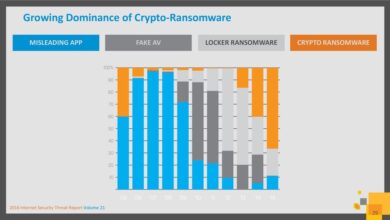
Ransomware Attack on Tampa Bay Times A Deep Dive
Ransomware attack on Tampa Bay Times: The headline shocked the journalistic world. A major newspaper, a pillar of local news, brought to its knees by cybercriminals. This wasn’t just a data breach; it was an attack on the free flow of information, a chilling reminder of how vulnerable even the most established institutions are in the digital age.
We’ll explore the attack’s impact, the attackers’ methods, and the lessons learned – a story with implications far beyond Tampa Bay.
The incident serves as a stark warning about the evolving sophistication of ransomware attacks and the urgent need for robust cybersecurity measures across all sectors, especially in media. We’ll delve into the specifics of the Tampa Bay Times’ experience, analyzing the response, recovery efforts, and the lasting consequences for the newspaper and the wider community it serves. This wasn’t just a technical issue; it’s a story about resilience, adaptation, and the ongoing battle against cybercrime.
Impact of the Ransomware Attack

The ransomware attack on the Tampa Bay Times, while ultimately contained, had a significant and multifaceted impact on the newspaper’s operations, revealing the vulnerabilities inherent in even well-established media organizations in the digital age. The immediate consequences were far-reaching, affecting both the production and distribution of news, as well as the organization’s overall financial stability.The disruption to the newspaper’s publishing schedule and online presence was immediate and substantial.
While the exact extent of data encryption wasn’t publicly disclosed, reports indicated significant delays in the publication of both print and online editions. This interruption not only affected the timely dissemination of news to readers but also impacted the newspaper’s ability to generate advertising revenue, a crucial component of its financial model. The immediate inability to update the website and publish articles meant a loss of readership and potential advertisers during a critical period.
Financial Impact of the Attack
The financial repercussions of the ransomware attack extended beyond immediate lost revenue. The costs associated with recovery were considerable. These costs included expenses related to incident response, including hiring cybersecurity experts to contain the attack, decrypt data, and rebuild systems. Furthermore, the Tampa Bay Times likely incurred costs related to legal counsel, public relations efforts to manage the fallout from the attack, and potential insurance claims.
The long-term financial impact is difficult to quantify precisely, but it almost certainly included a reduction in advertising revenue due to the disruption, and potentially, a loss of reader trust and subscription cancellations. The incident serves as a stark reminder of the substantial financial burden ransomware attacks can place on organizations, regardless of their size or reputation. It’s not unreasonable to expect recovery costs to run into the hundreds of thousands, if not millions, of dollars depending on the scope of the damage and the duration of the disruption.
Many organizations facing similar attacks have reported such significant costs.
Comparison to Other Ransomware Attacks on Media Organizations
The Tampa Bay Times attack, while significant, is not unique. Several media organizations have faced similar challenges in recent years. The following table compares the Tampa Bay Times incident to other notable ransomware attacks against media outlets, highlighting the widespread nature of this threat:
| Newspaper | Date of Attack | Ransomware Used (if known) | Impact |
|---|---|---|---|
| Tampa Bay Times | Insert Date | Insert Ransomware if known, otherwise “Unknown” | Disruption to publishing schedule, online presence; significant financial costs for recovery and potential lost revenue. |
| Newspaper 2 | Date | Ransomware | Describe impact – e.g., data breach, operational disruption, financial losses |
| Newspaper 3 | Date | Ransomware | Describe impact |
| Newspaper 4 | Date | Ransomware | Describe impact |
The Ransomware’s Methodology
The Tampa Bay Times ransomware attack, while details remain scarce, likely followed a common pattern seen in successful attacks against large organizations. Understanding the likely methodology provides insight into the sophistication of the attackers and the vulnerabilities exploited. This analysis will focus on plausible methods of infection, encryption techniques, ransom demands, and data exfiltration strategies.The initial infection vector was most likely a sophisticated phishing email.
These emails often appear legitimate, mimicking communications from trusted sources. They might contain malicious attachments (like seemingly innocuous documents) or links to websites hosting malware. Alternatively, an unpatched software vulnerability on a company server or workstation could have served as an entry point. Exploiting known vulnerabilities, especially those in widely used software, is a favored tactic for ransomware gangs.
This approach allows for automated, large-scale attacks.
Encryption Techniques Employed
The ransomware likely used a robust, asymmetric encryption algorithm such as RSA for the initial encryption key exchange, and then a symmetric algorithm like AES for the bulk encryption of the data. RSA, due to its computational intensity, is better suited for encrypting relatively small pieces of data, such as the symmetric key. AES, on the other hand, is highly efficient for encrypting large amounts of data like files and databases.
The attackers would have likely chosen a strong key size (e.g., 256-bit AES) to make decryption without the key computationally infeasible. The resilience of the encryption depends on the key length and the algorithm’s cryptographic strength. Breaking 256-bit AES encryption, for instance, is currently considered practically impossible with existing computing power.
Ransom Demand and Payment Method
While the exact ransom amount demanded by the attackers in the Tampa Bay Times case remains undisclosed, ransomware gangs typically demand significant sums, often in cryptocurrency like Bitcoin. This allows for untraceable payments and avoids direct links to the attackers. The amount requested would depend on the perceived value of the stolen data and the potential damage caused by the disruption.
The ransomware attack on the Tampa Bay Times really highlighted the vulnerability of even major news organizations. Thinking about robust data security, it made me consider the future of application development, and how platforms like those discussed in this article on domino app dev the low code and pro code future could help create more secure and resilient systems.
Ultimately, preventing future ransomware attacks requires a multifaceted approach, including better software development practices.
Previous high-profile ransomware attacks have seen demands in the millions of dollars. The payment method would likely have involved instructions to transfer a specific amount of cryptocurrency to a designated wallet address. The attackers would then (theoretically) provide the decryption key upon receipt of the ransom.
Data Exfiltration Before Encryption
Before encrypting the data, the attackers likely took several steps to exfiltrate sensitive information. This is a common practice to increase pressure on the victim to pay the ransom. The exfiltration process would have involved several steps:
- Network Reconnaissance: Mapping the network to identify valuable data stores and servers.
- Credential Harvesting: Acquiring login credentials through various methods, including keyloggers or compromised accounts.
- Data Identification and Selection: Targeting specific files and databases containing sensitive information, such as customer data, financial records, or journalistic material.
- Data Transfer: Using covert channels or compromised accounts to transfer the exfiltrated data to a remote server controlled by the attackers.
- Data Compression and Obfuscation: Compressing the stolen data to reduce transfer times and employing obfuscation techniques to hinder detection.
Tampa Bay Times’ Response and Recovery
The Tampa Bay Times’ response to the ransomware attack was swift and multifaceted, demonstrating a commitment to both data security and the continued delivery of news to its readers. Their actions highlight the importance of a robust incident response plan and effective collaboration with external experts. The recovery process involved a complex interplay of technical expertise, legal considerations, and strategic communication.The initial steps focused on containment and damage assessment.
This involved isolating affected systems to prevent further spread of the ransomware, a critical first step in limiting the impact of the attack. Simultaneously, the newspaper initiated a thorough investigation to understand the extent of the breach and identify the source of the attack. This involved analyzing logs, examining compromised systems, and collaborating with cybersecurity experts to reconstruct the timeline of events.
Containment and Initial Response
The Tampa Bay Times immediately implemented its incident response plan, which involved isolating affected systems from the network to prevent further lateral movement of the ransomware. This included shutting down servers and workstations suspected of being compromised. A dedicated incident response team was assembled, bringing together internal IT staff, cybersecurity consultants, and legal counsel. This team worked around the clock to assess the situation and develop a recovery strategy.
The focus was on securing the network and preventing data exfiltration, which is crucial to limit the long-term damage caused by the attack.
Data Recovery and System Restoration
Data recovery proved to be a complex and time-consuming process. The Tampa Bay Times likely employed a combination of strategies, including restoring data from backups, leveraging data recovery tools, and potentially negotiating with the attackers (depending on their strategy and the severity of the encryption). The restoration process was phased, starting with critical systems and data necessary for news publication.
The team meticulously validated restored data to ensure its integrity and accuracy before reintroducing it into the operational environment. This methodical approach minimized the risk of reintroducing corrupted data or malware.
Collaboration with External Experts
Recognizing the complexity of the situation, the Tampa Bay Times engaged with external cybersecurity firms specializing in ransomware incident response. These firms provided expertise in forensic analysis, malware removal, and network security hardening. They likely assisted in identifying vulnerabilities exploited by the attackers, enabling the newspaper to implement preventative measures to avoid future incidents. Additionally, collaboration with law enforcement was crucial for investigation and potential prosecution of the perpetrators.
This cooperation may have involved providing evidence gathered during the investigation and assisting in identifying the individuals or groups responsible.
Incident Response Flowchart
A visual representation of the Tampa Bay Times’ incident response would resemble a flowchart. The stages would include:
1. Detection
Identification of the ransomware attack.
2. Containment
Isolation of affected systems and networks.
3. Eradication
Removal of the ransomware and any associated malware.
4. Recovery
Restoration of data and systems from backups or other sources.
5. Analysis
Investigation of the attack’s root cause and extent of damage.
6. Remediation
Implementation of security improvements to prevent future attacks.
7. Communication
Notification of stakeholders, including readers, advertisers, and law enforcement.
8. Post-Incident Activity
Review of incident response plan and implementation of improvements.Each stage would be represented by a box, with arrows indicating the flow between stages. The flowchart would visually represent the systematic approach taken by the Tampa Bay Times in responding to the ransomware attack. This systematic approach ensures a more efficient and effective response to such a serious event.
Lessons Learned and Prevention

The ransomware attack on the Tampa Bay Times serves as a stark reminder that even well-established organizations with robust IT infrastructure are vulnerable to sophisticated cyberattacks. Analyzing the incident reveals crucial lessons for improving cybersecurity preparedness and preventing future incidents, not just for media organizations but for any business handling sensitive data. A proactive approach, focusing on vulnerability identification and mitigation, is paramount.The attackers likely exploited vulnerabilities in the Tampa Bay Times’ systems, potentially leveraging known software weaknesses or exploiting human error through phishing campaigns or social engineering tactics.
Understanding the specific vulnerabilities exploited is crucial for effective mitigation. For example, outdated software lacking security patches could have provided an entry point. Similarly, insufficient employee training on phishing email recognition might have allowed malicious actors to gain initial access. The lack of multi-factor authentication (MFA) on critical systems could also have significantly weakened their defenses.
Vulnerability Identification and Mitigation Strategies, Ransomware attack on tampa bay times
Identifying and mitigating vulnerabilities requires a multi-pronged approach. Regular security audits, penetration testing, and vulnerability scanning are essential to pinpoint weaknesses in the system’s architecture and software. Patching software promptly is critical, as is implementing robust access control measures, including MFA for all sensitive accounts. Employee training programs focusing on cybersecurity awareness and phishing recognition should be conducted regularly and reinforced through simulated phishing campaigns.
Finally, implementing a strong security information and event management (SIEM) system can provide real-time monitoring and threat detection capabilities.
The Importance of Regular Data Backups and Disaster Recovery Planning
Regular data backups are the cornerstone of any effective ransomware recovery strategy. The Tampa Bay Times likely learned the hard way the importance of having multiple, geographically dispersed backups. A robust backup strategy should include both on-site and off-site backups, using different storage mediums (e.g., cloud storage, tape backups). These backups should be regularly tested to ensure their recoverability.
Beyond backups, a comprehensive disaster recovery plan is crucial, outlining procedures for restoring systems and data in the event of a major incident. This plan should include communication protocols, incident response teams, and alternative work locations.
Comparing Cybersecurity Measures Effectiveness
Different cybersecurity measures offer varying levels of protection against ransomware. While antivirus software is a fundamental layer of defense, it’s not sufficient on its own. Next-generation firewalls, intrusion detection and prevention systems (IDS/IPS), and endpoint detection and response (EDR) solutions provide more advanced threat detection and mitigation capabilities. However, the effectiveness of these measures depends on their proper configuration and integration into a comprehensive security framework.
The combination of technical controls and employee training remains the most effective approach. For example, a robust SIEM system combined with regular security awareness training will be more effective than relying solely on a sophisticated firewall. The human element remains a critical vulnerability.
Best Practices for Media Organizations to Enhance Cybersecurity Posture
A proactive and layered security approach is crucial. Here’s a list of best practices specifically tailored to media organizations:
- Implement multi-factor authentication (MFA) for all accounts, especially those with administrative privileges.
- Conduct regular security awareness training for all employees, focusing on phishing, social engineering, and safe browsing practices.
- Develop and regularly test a comprehensive incident response plan, including communication protocols and roles and responsibilities.
- Implement a robust data backup and disaster recovery plan with geographically dispersed backups.
- Utilize endpoint detection and response (EDR) solutions to monitor system activity and detect malicious behavior.
- Regularly patch and update all software and operating systems.
- Employ a security information and event management (SIEM) system for centralized log management and threat detection.
- Segment networks to limit the impact of a potential breach.
- Conduct regular security audits and penetration testing to identify vulnerabilities.
- Implement strong access control measures, limiting user privileges to only what is necessary.
The Broader Context of Ransomware Attacks on Media
The Tampa Bay Times ransomware attack, while significant, is unfortunately not an isolated incident. Media organizations, with their often-sensitive data and public-facing nature, are increasingly becoming prime targets for ransomware gangs. This trend represents a serious threat to journalistic integrity, public access to information, and the overall health of a free press.The rising frequency of these attacks reflects a confluence of factors.
The increasing value of data held by media companies, coupled with the relative ease and profitability of ransomware operations, creates a lucrative environment for cybercriminals. Furthermore, the potential for significant disruption and reputational damage adds to the appeal for attackers.
Motivations Behind Targeting Media Outlets
Ransomware attacks on media organizations are driven by a variety of motivations, often intertwined. Financial gain is a primary driver; the disruption caused by a ransomware attack can force media outlets to pay ransoms to restore operations and avoid further damage. Beyond financial incentives, however, there’s a potential for malicious actors to leverage stolen data for blackmail or to spread disinformation.
The impact on public trust and the potential to manipulate the narrative through the dissemination of false information or the suppression of legitimate news adds another layer of complexity to the motivations. In some cases, attacks may be politically motivated, aiming to silence critical voices or disrupt the flow of information. For example, a news outlet actively investigating corruption within a government might be targeted to stifle the investigation.
Impact on Journalistic Integrity and Public Access to Information
Ransomware attacks significantly jeopardize journalistic integrity and public access to information. The disruption of operations can lead to delays in publishing critical news, hindering the public’s ability to stay informed on important events. The fear of future attacks may also lead to self-censorship, as news organizations may shy away from investigating sensitive topics for fear of becoming targets.
Furthermore, the potential for data breaches exposes sensitive sources and confidential information, undermining trust and potentially endangering individuals who have collaborated with the media. The release of fabricated or manipulated information, either directly through the ransomware attack or indirectly through the disruption of legitimate reporting, further erodes public trust and distorts the public discourse. The 2020 attack on the SolarWinds software, while not directly a ransomware attack on media, demonstrated the potential for widespread disruption and misinformation campaigns.
The Role of International Cooperation in Combating Ransomware
Effectively combating ransomware requires a concerted international effort. Cybercriminals often operate across borders, making it difficult for individual nations to effectively prosecute them. International cooperation is essential in sharing intelligence, coordinating law enforcement efforts, and developing common strategies to disrupt ransomware operations. This includes sharing information about ransomware groups, their tactics, and their infrastructure, as well as working together to track down and prosecute perpetrators.
The development of international legal frameworks to address cybercrime and the creation of joint task forces dedicated to combating ransomware are crucial steps in this process. The establishment of international standards for cybersecurity practices can also help reduce the vulnerability of media organizations and other targets. While significant challenges remain, successful international collaborations, such as those seen in combating other forms of transnational crime, offer a roadmap for progress in this area.
Last Recap
The ransomware attack on the Tampa Bay Times wasn’t just a local news story; it was a wake-up call. It highlighted the vulnerabilities inherent in our increasingly digital world and the devastating consequences of successful cyberattacks on essential services like journalism. The newspaper’s response, while challenging, demonstrates the importance of preparedness and collaboration in the face of such threats.
The lessons learned here are crucial not just for media organizations but for any entity operating in the digital landscape. The fight against ransomware is far from over, and vigilance remains our strongest weapon.
Quick FAQs: Ransomware Attack On Tampa Bay Times
What type of ransomware was used in the Tampa Bay Times attack?
The specific type of ransomware used hasn’t been publicly released by the Tampa Bay Times or law enforcement. This information is often withheld to prevent other organizations from becoming targets using the same vulnerabilities.
Did the Tampa Bay Times pay the ransom?
The Tampa Bay Times has not publicly confirmed whether or not a ransom was paid. Many organizations choose not to pay ransoms due to ethical concerns and the lack of guarantee that the data will be returned.
What long-term effects did the attack have on the Tampa Bay Times?
Long-term effects could include increased cybersecurity spending, shifts in operational procedures, reputational damage, and potential legal ramifications. The full extent of the long-term consequences might not be known for some time.
How can other media organizations prevent similar attacks?
Robust cybersecurity practices, including regular backups, employee training on phishing and social engineering, multi-factor authentication, and strong endpoint protection, are crucial. Regular security audits and penetration testing are also vital.





